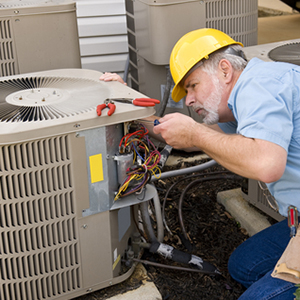- >
A Guide to Testing Indoor Air Quality
- By: Cheli Scott
- Date: Oct 25 2022
Similar Articles
What you Need to Know About Ductless Air Conditioning
Many consumers are unfamiliar with ductless air conditioning systems. We've assembled some info to help you learn!
How to Choose a Replacement Thermostat
The part of your HVAC system you interact with the most is your thermostat so let us help you choose the right one for your home!
How to Air Balance your Home
If you are concerned about your current system's performance, it may be time to consider investigating how to air balance your home.
Testing indoor air quality
It may be surprising to learn, but the air in your home can potentially be the most polluted air you interact with; so testing your indoor air quality is essential to your health. Since people can spend up to 90 percent of their time indoors, there is a lot of opportunity to be exposed to poor indoor air quality.
The chronically ill, elderly, and children are often the most susceptible to indoor air quality in your home. Even if you are not experiencing chronic illness, you may have problems related to indoor air quality like fatigue, respiratory distress, and fever.
There are a number of potential pollutants that can contribute to poor indoor air quality including mold, pet dander, chemical pollutants, tobacco smoke, and dust mites, amongst other particles.
If you are experiencing respiratory ailments it may be time to consult an HVAC specialist about upgrading your home’s air conditioning system to improve home air quality.
An indoor air quality monitor can also reveal the amount of pollutants in your air, so that you can take steps to improve air quality.
What contributes to poor indoor air quality
Poor indoor air quality can come from a number of sources. There may be chronic contributors to home air pollution, as well as unique events that will worsen air quality periodically.
For example, if you have your home remodeled, you may see a sudden rise in dust particulate in the air. While leaks in your home can lead to chronic mold and mildew.
Appliances in your home give off chemical pollutants that can build up in your home over time. For example, your home furnace gives off a small amount of carbon monoxide.
Even things as simple as house hold cleaning products, candles, and air fresheners contribute to chemical pollutants in your air.
While there is no way to completely avoid releasing pollutants into your air, ventilation plays a big part in how that pollution effects you. If there is poor ventilation in your home, pollutants will build up and can cause health problems.
Purchasing an indoor air quality monitor
If you are concerned with indoor air quality, the first step is to test your current air quality and see where you stand. Air quality testing can be performed at home with commercially available monitors.
Air quality monitors can range from $100 to $300 depending on the quality and what they measure. Most air quality monitors will measure temperature, humidity, and may measure particulate matter and chemicals depending on the brand you buy.
Chemical contributors to poor indoor air quality
Radon
The Environmental protection agency (EPA) emphasizes the importance of testing for radon gas in your home. Radon is an odorless, colorless gas found in our soil and is linked to lung cancer. 1 in 15 homes has been found to have elevated levels of Radon.
The gas seeps into your home through cracks in the floor, unfinished basements, and sometimes wells, so it is generally unavoidable to some degree. However, sealing your home well can help improve indoor air quality by reducing the amount of Radon leaking into your home. You can also reduce the amount of Radon you are exposed to by increasing ventilation. Periodically open windows and use fans to move stale air outside.
While every home has some amount of the gas, there is no safe level of Radon, so it is essential to your health to reduce your exposure over the long term. Radon is the number one cause of lung cancer among non-smokers.
If after you test air quality you find a high amount of Radon, it is time to call a professional technician to help you develop a radon reduction plan. A technician will be able to design a ventilation system to keep Radon out of your home.
Carbon monoxide
Carbon monoxide is another gas that can cause physical health problems if it is polluting your home. Appliances like your furnace give off a small amount of carbon monoxide gas when functioning properly, but if your furnace is broken there is a possibility it could be releasing significantly more and could potentially cause carbon monoxide poisoning.
Fireplaces are big contributors of carbon monoxide gas to your home. Wood burning fireplaces require special care to provide adequate ventilation for safe use. Keep your chimney clean to encourage the free movement of air.
It is an important safety measure to equip every home with carbon monoxide detectors. The EPA suggests having a trained HVAC technician inspect your furnace and fireplace annually for leaks before use.
Formaldehyde
Formaldehyde is a common chemical found in innocuous home items like insulation, particle board furniture, glue, and paint. If you are experiencing eye, nose, and throat irritation after a home remodel you may want to test for this chemical.
While the most effective formaldehyde test is performed by a trained technician, you can purchase an over the counter test for about $100.
As with any indoor air pollutants, ventilation is key to limiting exposure. It’s important to use proper ventilation when painting your home or engaging in craft projects that use industrial glues and enamels. Open windows, use fans, or work outside if possible.
Biological contributors to poor air quality
Mold
Mold and mildew can have a noticeable effect on physical health. If you are experiencing fatigue or sudden respiratory problems, it may be worth inspecting your home for hidden sources of mold.
Mold develops in moist areas that can develop because of leaks or condensation build up. Often the first and most noticeable signs of mold is a foul smell.
While you may be tempted to cover the scent with air fresheners, don’t ignore it. A little moisture leak can lead to big problems down the line.
You can purchase a mold testing kit at your local hardware store to check for mold spores if you are unsure.
Bacteria
Similarly to mold, bacteria will breed in moist areas. It’s best to keep your home’s indoor humidity between 30 and 50 percent to prevent the development of harmful bacteria in ventilation systems.
If you find you need a humidifier, be sure to change the water daily as bacteria can breed quickly in these small appliances.
You can also test air quality with simple bacteria testing kits that can be purchased at home improvement stores.
Testing air quality in your home
Indoor air quality testing is an important safety task for every homeowner. Since we spend so much time in our homes, the air quality is paramount to our health.
Indoor air contaminants are largely invisible, so without proper testing there is no way to know if you are at risk. An annual indoor air quality assessment will give you the opportunity to test your home for common pollutants and adjust your ventilation system as needed.
Air quality monitors are available in a range of prices to keep track of the particulate matter and chemicals in your air. As a homeowner it is worth investing in one to keep your family safe from noxious chemicals.
Ventilation in your home
Proper ventilation is a key part of improving your home’s indoor air quality. It’s a good idea to meet with a technician and discuss ways you can improve ventilation in your home.
This is especially important if you use appliances that give off toxic gasses. Open windows often and use fans and vents to facilitate moving fresh air into your home.
If your home uses a wood stove, you should be sure to purchase brands that carry the Energy Star label and ensure you keep your flue clean and open.
The role of maintenance in air quality testing
Properly maintaining your appliances is another key element to improving air quality. Have your HVAC system inspected annually to ensure your system is functioning properly. Refrigerant leaks, collected moisture, and clogged filters can lead to excess particulate matter in your air or mold growth.
Testing your air quality in your home can also give you clues that there are problems with your HVAC system. Excess moisture, leading to mold growth can be a sign you have a leak somewhere or your air conditioner coils are freezing.
Don’t be afraid to ask for help
An experienced HVAC technician will be able to guide you in the right direction if you are unsure about your indoor air quality testing. Professional tests are often more expensive, but more accurate, so if you are experiencing an acute problem, don’t be afraid to reach out.
Your indoor air quality is important to your health. Exposure to chemicals and molds can cause sickness over both the long and short term.
If you are a person who already experiences allergies or respiratory conditions like asthma, the condition of your HVAC system is even more important to your well being.
While the Environmental protection agency has some ways you can reduce indoor air pollution yourself, a technician will have the experience to make choices unique to your conditions.
Be sure to work with a professional technician like the ones at bhild.com. Call us today, or fill out our form here for a free estimate on HVAC services!











